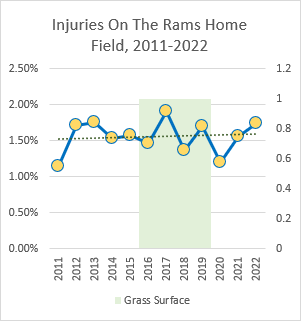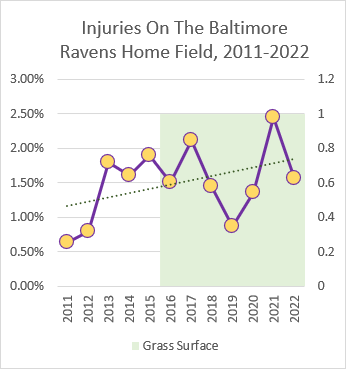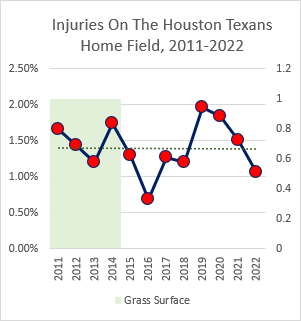Last Monday, disaster struck the New York Jets despite winning their season opener. Their high profile roster acquisition of Aaron Rodgers went down for season with a torn Achilles tendon after playing only four snaps. This led to much criticism over the artificial turf in East Rutherford, New Jersey. Rodgers’s former teammate David Bakhtiari was very quick to condemn the playing field. NFLPA executive director Lloyd Howell made it clear that the union wants grass surfaces for all NFL games. Criticisms over artificial turf have lasted almost as long as has it’s been used, of course–but Rodgers’s serious energy has risen the salience of the criticism once again.
Given this currently high salience, I thought I’d try to take a look at some history of recorded injuries on grass versus artificial surfaces. Thanks as always to the compilation of play by play data by nflverse, it was easy enough to compile such recordings in gamebooks from 2011 to 2022 to gain a little bit of insight on the subject. The compiled data can be found on this page.
Findings
For regular season games from 2011 to 2022, including neutral fields played internationally, artificial fields indeed sustained a higher percentage of recorded injuries, occurring on 1.67% of snaps–as opposed to 1.53% on grass fields. This higher percentage was also consistent across all types of additional designations made to injuries–consisting of players being declared Out, Doubtful, Questionable, or given no designation at all.
When broken down by team, there remains a lean of higher injuries at some stadiums that use artificial turf. Six of the highest nine teams have exclusively used artificial turf since 2011–and a seventh, the Chargers, moved to a stadium that uses it–and indeed, the highest number of injuries sustained in Chargers home games over this period was in their first season in Inglewood, and also sustaining 2% of snaps the season afterward. (The Rams, who I’ll address soon, did not show such a trend on the same field, but they are notable for winning a Super Bowl on their home field but with Odell Beckham Jr. suffering an ACL tear in the game.) But there are also other artificial fields that have fared more favorably on the injury front. The Seahawks and Bills are two teams exclusively using artificial fields that rank in the bottom seven of recorded injuries sustained on their fields.
It’s also instructive to look at a few teams that have switched between grass and artificial surface. The Chargers were mentioned above, but here are the visual trends for the Rams, Ravens, and Texans, none of which not show any notable discrepancies in their surface oscillations:



Indeed, for the Ravens, two possible outlying seasons in 2011 and 2012 make it look the switch to grass sustained more injuries, even though when removing them the consistency is quite uneven one way or the other. This lack of consistency of injuries on grass versus artificial surfaces is common when focusing on single seasons or single team histories
Limitations
Recordings of injuries in the gamebooks are only as good as who’s doing the recording. And nothing deserves more warning than whatever the recorders for games in Tampa prior to 2019 were doing.
Most teams will see recorded injuries sustained on their home fields per season in the teens to 20s, with particularly vicious seasons entering the 30s or even 40s. But with the Bucs prior to 2019, no gamebook recorded more than 5 injuries per season, and a few even recorded no injuries at all. It is very easy to come up with counterexamples to challenge the veracity of these recordings–for example, in one such season (2016) in which no injury was recorded, there was a game against the Broncos where starting quarterback Trevor Siemian was injured late in the second quarter and did not return. The gamebook does not mention any injury of Siemian whatsoever.
There are also some oddities as to whether the gamebook bothers to apply designations to the injuries. For example, at games in East Rutherford from 2011-2022, only 3 injuries each in games hosted by the Jets and Giants were injuries given any designation at all. Nonetheless, in Monday’s game there (not currently included in this range), Aaron Rodgers was explicitly declared to be Out in the gamebook, making for a very rare case in this regard. The Patriots and Bengals, the league leaders over this range, also are notable for recording many injuries but not giving many designations for the injuries. It’s reasonable to consider whether the recorders are more diligent in just getting any sign of injury in the books in Foxboro and Cincinnati.
But the most important limitation is all the injuries that are unrecorded. Players take a beating on the majority of snaps, even if they do not miss snaps due to it, and the surface is often a source of where the beating is induced. If players notice that their bodies are taking a disproportionate beating on certain surfaces, that should be acknowledged and seriously considered. In return, there is also the consideration of the difficulties of maintaining a grass field in certain climates, and in retractable or domed roof stadiums–for example, as seen when the Texans moved away from grass soon after the 2015 season began. And as always, in any situation where players and owners have differing opinions, collective bargaining may come into play to enact changes.
With those limitations in mind, feel free to take a look at the data yourself on the centralized page, and see if there is anything else notable that I have yet to mention.